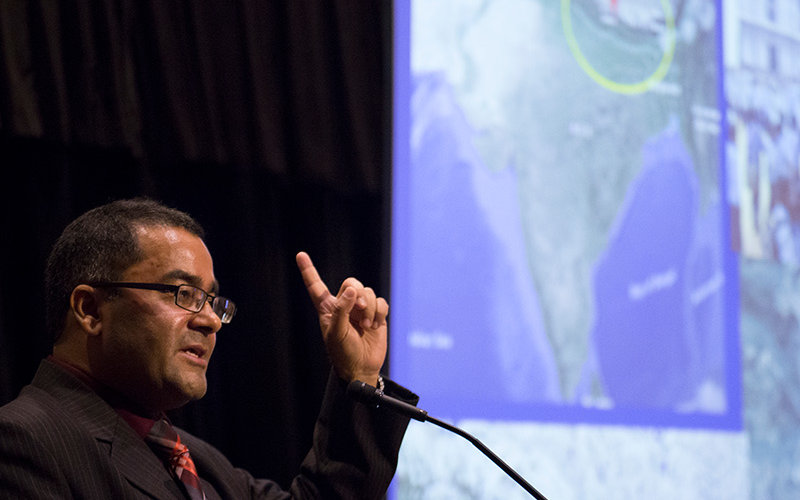
How to live with natural disasters, the damage and the suffering they often cause has been the focus of years of research and study for Cal State Fullerton professor Binod Tiwari, professor of civil and environmental engineering and an expert in geotechnical engineering.
On March 6, that wide-ranging and dedicated study was the focus of the 2017 Outstanding Professor Award recipient’s lecture before campus peers and students.
The scholar discussed his faculty-student research to reduce the destruction, as well as the loss of property and lives from landslides, earthquakes, floods, hurricanes and wildfires.
“There are several kinds of major natural disasters that have been identified by FEMA (Federal Emergency Management Agency) and the U.N. They are earthquakes, landslides, floods, storms and hurricanes, extreme weather, tsunami, wildfires and volcanic eruptions,” he said. “Today, I’m going to focus on earthquakes and landslides.”
In the United States alone, natural disasters are responsible for the deaths of 477 people and approximately $104 billion in property loss each year, according to the U.N. International Strategy for Disaster Reductions. In many other parts of the world, these numbers are significantly higher.
Californians — and those living in the other states along the West Coast — are included in what is called the Ring of Fire — a “ring” stretching across the Pacific Ocean to Asia and North and South America that has the highest potential for earthquakes and volcanoes.
“Of course, earthquakes also lead to tsunamis, landslides, fire, disease, and often, unfortunately, crime,” said Tiwari.
In 2011, a 9.1 magnitude earthquake struck Tohoku, Japan, killing 15,878 people and causing $360 billion worth of property damage. In addition, 20,000 were injured and 130,000 people were displaced. While many buildings sustained damage or tilted at dangerous angles, the majority of the deaths and property damage were due to the devastating tsunami that followed the earthquake, said the researcher who studied the earthquake’s destruction and serves as a board member of the International Consortium on Landslides.
In 2015, a magnitude 7.8 earthquake killed 8,000 people in Nepal and caused six billion dollars’ worth of structural damage. More than 15,000 landslides occurred as a result of ground instability. Because buildings weren’t built to withstand earthquakes of that magnitude, they “pancaked” with the upper floors falling straight through to the lower floors. Boulders rolled down hills and smashed whatever was in their way.
Tiwari was on the ground, leading Geotechnical Extreme Event Reconnaissance Team following those earthquakes in Nepal. A native of Nepal, he led a team of U.S. and international engineering and geotechnical experts who collaborated with various Nepalese organizations, including academic institutions, government organizations and professional societies, to help assess the damage and learn how to deal with such disasters in the future.
“In earthquakes, we often see liquefaction where the underground water table is under so much pressure that it pushes up through the surface,” he said. “It’s as if you took a plastic bottle of water and squeezed it. The pressure of the squeezing forces the water to shoot out of the top of the bottle. If the groundwater pressure is high, buildings lose their stability and tilt over or break apart. Bridges, dams and roads are impacted as well. Lack of road access impedes rescue operations.”
Landslides, as the surface loses stability, are also a common occurrence following major earthquakes.
“Natural disasters are inevitable,” Tiwari said. “But learning about those disasters help us prepare to face or reduce the consequences. Each country has specific types of natural disasters, depending on their geographic, climatic, topographic and geologic conditions. We need to learn from past disasters in order to design a safer infrastructure.
“At Cal State Fullerton, we have more than 100 students working on various projects to build safer infrastructures that can better withstand these forces of nature.”